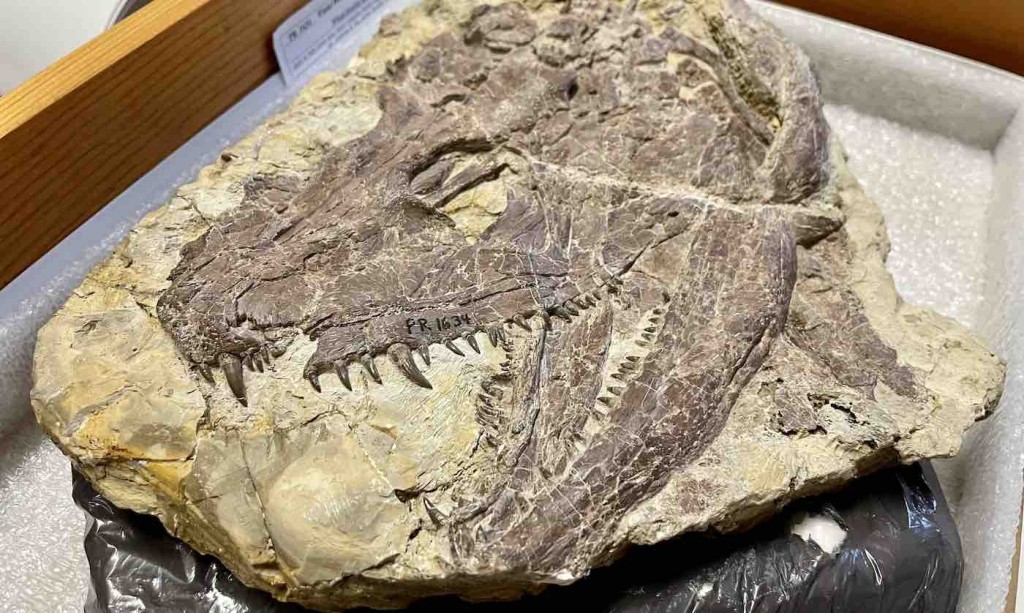
A terrifying predator that lived 340 million years ago has been dubbed “the T. rex of its day.”
Named Whatcheeria deltae, it had huge razor sharp teeth, and as well as being one of the first creatures ever to hunt on land, it had growth patterns rather more like humans than reptiles, amphibians, or fish.
It had a salamander like body and long narrow head reaching more than six feet from nose to tail, and a new study examining its thigh bone has revealed that unlike modern amphibians, whatcheeria grew very fast.
In general this fascinating creature, as the authors put it “blurred the ostensible divide between aquatic and terrestrial adaptations.”
“If you saw watcheeria in life, it would probably look like a big crocodile-shaped salamander, with a narrow head and lots of teeth,” said study co-author Ben Otoo, a Ph.D. student at the University of Chicago. “If it really curled up, probably to an uncomfortable extent, it could fit in your bathtub, but neither you nor it would want it to be there.”
Dr. Otoo and his colleagues examined around 350 specimens housed in the Chicago Field Museum, ranging from single bones to complete skeletons.
Bony grooves in its skull for sensory organs reveal it spent most of its time underwater.
“It probably would have spent a lot of time near the bottoms of rivers and lakes, lunging out and eating whatever it liked,” said Otoo. “You definitely could call this thing ‘the T. rex of its time.'”
But why are scientists interested in whatcheeria’s growth speed? It’s because the animal was part of the lineage that eventually evolved into the four-limbed animals alive today—including humans.
“Whatcheeria is more closely related to living tetrapods like amphibians and reptiles and mammals than it is to anything else, but it falls outside of those modern groups,” said co-author Dr. Ken Angielczyk, a curator at the Field Museum. “That means that it can help us learn about how tetrapods, including us, evolved.”
Whatcheeria was a tetrapod, a group that includes amphibians, reptiles, mammals and birds. They evolved from the lobe-finned fishes in the middle-Devonian Period, which began 419 million years ago.
SIMILAR: Scientists Unearth Africa’s Oldest Known Dinosaur, Filling a Critical Gap in the Fossil Record
Some whatcheeria at the Field Museum are six-and-a-half feet long, while others are much smaller. That means there was an opportunity to study how they grew.
The researchers analyzed fibrolamellar, or thigh bones from nine individuals ranging from juvenile to adult under a microscope. When an animal is growing, its bones create growth rings much like a tree, which can inform a scientist as to the speed of various growth phases.
In modern tetrapods, some animals grow a lot as juveniles and then stop when they reach adulthood. Birds and mammals, including us, are like that. But other animals like crocodiles and many amphibians keep growing bit by bit their whole lives.
RELATED: One of the Largest ‘Sea Dragon’ Fossils Ever Found in Britain Unearthed As a Complete Ichthyosaur
The study found whatcheeria grew rapidly when it was young, and then leveled off over time, giving it a strange inter-eonal connection with us. The reason, say the authors, is that being an apex-predator often requires animals to become big, fast. This makes it easier to hunt and harder to be hunted.
But growing really big really fast takes an enormous amount of energy, which can be a problem if there is not enough food and resources.
As well as shedding fresh light on the early tetrapods, the findings are a reminder that evolution isn’t a neat step-by-step process, but a series of experiments.
“Evolution is about trying out different lifestyles and combinations of features,” said Dr. Angielczyk, “and so you get an animal like whatcheeria that is an early tetrapod, but it’s also a pretty fast-growing one. It’s a really big one for its time.”
MORE FOSSIL NEWS: This 120-Million Year Old Bird/Dinosaur Hybrid Is Teaching Us How Birds Came to Be
“It has this weird skeleton that’s potentially letting it do some things that some of its contemporaries weren’t. It’s an experiment in how to be a big predator, and it shows how diverse life on Earth was and still is.”
SHARE This Radically Cool Animal With Your Friends…




















